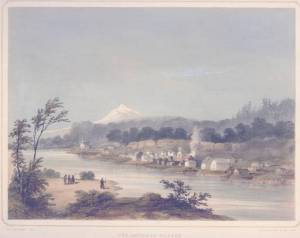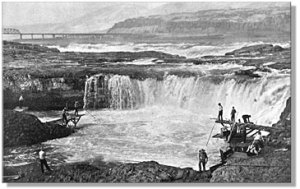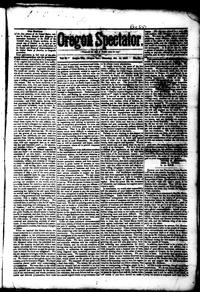
If the emigrants on the Oregon Trail were fortunate, they reached Oregon City in the Willamette Valley sometime in October – about six months after they began their journey from what was then the United States. The dangers of their trek continued even through the last weeks, when the travelers had to choose between rafting the roiling Columbia River, or trekking up and down the horrific Barlow Road around Mount Hood.
But finally, in the Willamette Valley, the emigrants found a land of beauty and bounty. They were often out of supplies and money, and their health was spent. Everything they owned had gone into the journey.

Oregon City sat where Willamette Falls stopped all boat traffic up the Willamette River from the Columbia. It had been a Native American trading site before the white settlers arrived.
Dr. John McLaughlin, Chief Factor of Hudson’s Bay Company at nearby Fort Vancouver, had started a fur trading post at the Willamette Falls site in 1829, and also built a mill harnessing the power of the falls. Methodist missionaries from the United States came to the area in the 1830s, and the missionaries encouraged other Americans to follow, including George Abernethy, who established a store competing with Hudson’s Bay Company.

Oregon City was incorporated in 1844, the first incorporated city west of the Rocky Mountains. In 1845, Oregon City became the seat of Oregon’s Provisional Government, with Abernethy as the first governor. The town opened a library and a jail. By 1846, the town had a population of over 500 people.
The Oregon Treaty in 1846 established the boundary between the U.S. and Canada in the West at the 49thparallel, effectively ending the Hudson’s Bay Company’s rights in the Oregon Territory. Nevertheless, McLoughlin gave the American travelers provisions and carried their accounts on the Hudson’s Bay Company books until they filed their land claims and got their first crops in. If it weren’t for this British citizen, the Americans might not have been so successful in established their foothold in Oregon.
But with McLoughlin’s help, Americans in Oregon thrived. By 1849, the population was over 900, even though one-quarter of the male population left Oregon City for California in the Gold Rush (which hit Oregon in 1848, a year ahead of the famous Forty-Niners.) Oregon City had the only federal land claims office in the West, so in 1849 the plat for San Francisco had to be sent to Oregon City to be filed.
It is against this backdrop that the events of my Oregon Trail novels take place. I found some fascinating resources on Oregon City history.

One resource was a hand-drawn map of Oregon City in 1846. This original part of Oregon City is only two or three blocks wide, but from this narrow footing, much of the Pacific Northwest was settled.
Although this picture is too small to see, the map shows the location of the mills at the Willamette Falls, where the two churches (Methodist and Catholic) were, and a variety of other buildings. The map shows also that Oregon City was trapped between a bluff of 120 feet and the river, which led to many floods throughout the town’s history.

Another resource was the archives of the Oregon Spectator newspaper. The Spectator, which started publishing in 1846, was the first American newspaper west of the Rockies. Many of the online digital archives are nearly illegible, and many of the articles are advertisements (not much has changed in 160 years). Still, I could read enough to ground some of the events in my novels in the newspaper accounts.
The edition portrayed in this picture was published on October 14, 1847, the same week that the wagon train depicted in my novel arrived in Oregon City. Most of the first page of this edition is a letter sent by Oregonians to the federal government in Washington, asking for assistance and protection.
And another resource was the diaries of people who settled in Oregon City. In November, I’ll write a post featuring the story of one of these settlers.




Love the old photos and maps. Nice. I’d never have thought of looking for old newspaper stories. Have to remember that! Thanks.
[…] I wrote in my last post about the Oregon Trail, the emigrants wanted to get to Oregon before the winter weather set in. Most travelers arrived by […]
[…] Road. I saw a painting of Oregon City by John Mix Stanley (circa 1852), which I could compare with the 1846 map I had found in my earlier […]
[…] mentioned the grueling Barlow Road around the south slope of Mt. Hood before. Barlow Road was the last leg of the Oregon Trail for the […]
[…] mentioned old newspapers as valuable sources of information before, and I am fortunate that the locales where my novel is set have papers from the 1840s and […]
[…] written about Dr. John McLaughlin in an earlier post. Although British by birth, he was called the “Father of Oregon” because he helped so many […]
Love the old photos and maps. Nice. I’d never have thought of looking for old newspaper stories. Have to remember that! Thanks.
[…] place to spend the winter. When the 1840s emigrants reached Oregon, many of them relied on the charity of John McLaughlin, chief factor of the Hudson’s Bay Company at Fort Vancouver. Later emigrants may have had family […]
[…] I wrote in my last post about the Oregon Trail, the emigrants wanted to get to Oregon before the winter weather set in. Most travelers arrived by […]
[…] research has been targeted on what I needed to know to write my novels. I can tell you a lot about Oregon City in 1847 and about the discovery of gold at Sutter’s Mill, but not much about early pioneers in […]
[…] Road. I saw a painting of Oregon City by John Mix Stanley (circa 1852), which I could compare with the 1846 map I had found in my earlier […]
[…] mentioned the grueling Barlow Road around the south slope of Mt. Hood before. Barlow Road was the last leg of the Oregon Trail for the […]
[…] mentioned old newspapers as valuable sources of information before, and I am fortunate that the locales where my novel is set have papers from the 1840s and […]
[…] written about Dr. John McLaughlin in an earlier post. Although British by birth, he was called the “Father of Oregon” because he helped so many […]
[…] place to spend the winter. When the 1840s emigrants reached Oregon, many of them relied on the charity of John McLaughlin, chief factor of the Hudson’s Bay Company at Fort Vancouver. Later emigrants may have had family […]
[…] research has been targeted on what I needed to know to write my novels. I can tell you a lot about Oregon City in 1847 and about the discovery of gold at Sutter’s Mill, but not much about early pioneers in […]
[…] Oregon City, now a suburb of Portland, Oregon, was one of the largest settlements in the West in the 1840s. Located at the Willamette Falls, which halted all boat traffic on the Willamette River, Oregon City was a natural stopping point for pioneers from the East. Starting with the Great Migration of 1843, Oregon City became the destination for many farmers and tradespeople. […]
[…] that, for the most part, relations between the U.S. and Canada have been positive. In the 1840s, John McLaughlin of the Hudson’s Bay Company helped many American pioneers who reached Oregon in dire […]